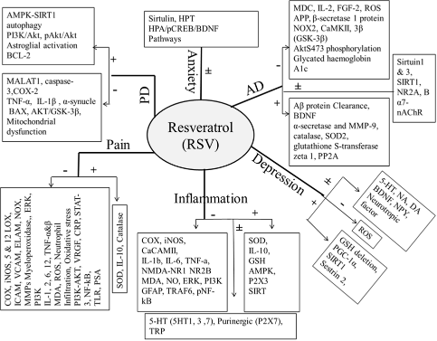Abstract
Resveratrol (RSV) is a plant polyphenol or phytolexin phytoconstituents obtained from the grapes, berries, peanut, and wine. RSV is obtained from natural source and regarded as safe, effective, and hepatoprotective drug with no other serious organ toxicities are reported yet. This property of RSV makes it advantageous over the allopathic medicine having symptomatic cure and plethora of adverse effects. It’s a cheap and widely available phytoconstituent approved in the global market in the active form as transresveratrol. It has multiple pharmacological actions including, analgesic, anti-inflammatory, anti-anxiety, anti-parkinsonian, anti-alzheimers, antioxidant, antidepressant, anti-cancer, anti-diabetic, anti-atherosclerotic effects. These effects are mediated via modulation of diverse underlying endogenous molecules like reactive oxygen species, nitric oxide, malonaldehyde, neutrophil, sirtulin, cyclo-oxygenase, inducible nitric oxide syntheses, superoxide dismutase, catalase, glutathione s-transferase, alpha-secretase, metalloproteinases, C-reactive protein, dopamine, nor-adrenaline, serotonin, cytokines (interleukins), nuclear factor kappa, signal transducer activator of transcription, brain derived neural nactor, neuropeptide, hypothalamo-pitutary axis, astroglia, mitochondrial dysfunction, glutamate, adrenergic, cholinergic, opioidergic, and purinergic receptors. Researchers are trying to explore its additional health benefits and preparing new analogues for better survival in the field. Present review will help to enlighten the multi-target pleiotropic pharmacological nature of a RSV in relation to the variety of the molecular targets modulation through extensive web science literature survey.
Full text article
Authors

This work is licensed under a Creative Commons Attribution-NonCommercial-NoDerivatives 4.0 International License.

